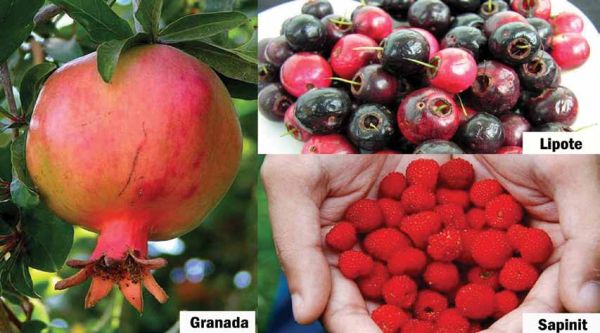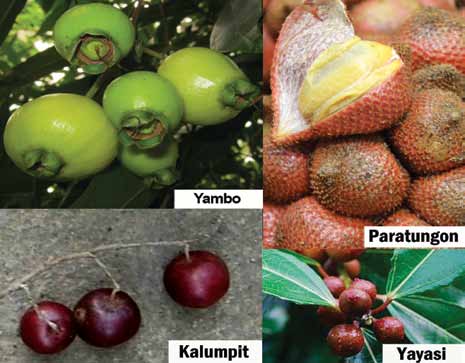Most young people nowadays are familiar with apples, grapes, plums, peaches, cherries, or pears. These are fruits that the Philippines imports from other countries because they only grow in cold climates. Meanwhile, indigenous fruits like anang, sapote, yambo, sapinit, katmon, kalumpit, lipote, binukaw, or paratungon are often given the boggled look and are being overlooked, not because they are not as delicious and as nutritious as their imported counterparts, but because most Filipinos are not familiar with them. Also, for some, eating these less-known, never-heard-of fruits is an acquired taste which needs some getting used to.
In an effort to mainstream these Pinoy fruits to the consuming public, particularly the young people, the Department of Agriculture (DA) has intensified its campaign of promoting the Philippines’ important and underutilized indigenous fruits.

In a recent pronouncement made by Secretary Proceso J. Alcala, he urged the Filipino consumers to give preference to our local fruit varieties that are produced by our farmers and orchard operators. Patronizing them, according to the agriculture chief, will not only promote good health among our people, but will also help the production and the profitability of the farming sector, and further strengthen our nation’s economy.
The secretary also mentioned the need to teach the Filipino consumers on how to appreciate these indigenous fruits because most of them are nutritious, and are high in phyto-chemicals and essential nutrients that are beneficial to one’s health. Their unique taste gives them great potential as exports products that can be considered distinctively Filipino.
Dr. Roberto E. Coronel, author of the book, “Important and Underutilized Edible Fruits in the Philippines” cited that the country has a rich collection of fruits that few other tropical countries can surpass or even equal in number. No less than 300 species that have been reported and a good number of them are economically important but are not yet fully utilized.
Some of the economically important fruits that are locally grown but are underutilized are: bayabas (Psidium guajava), atis (Annona squamosa), kaimito (Chrysophyllum cainito), chico (Manilkara zapota), guyabano (Annona muricata), duhat (Syzygium cumini), rambutan (Nephelium lappaceum), santol (Sandoricum koetjape), sinigwelas (Spondias purpurea), dalanghita (Citrus sinensis), avocado (Persea americana), mabolo (Diospyros blancoi), tiesa (Pouteria campechiana), balimbing (Averrhoa carambola), marang (Artocarpus doratissimus), aratilis (Muntingia calabura), mangosteen (Garcinia mangostana), lanzones (Lansium domesticum), dragonfruit (Hylocereus polyrhizus), and papaya (Carica papaya), among others.

Meanwhile, among those that are less-known or never-heard-of-fruit include: granada (Punica granatum), lipote (Syzygium curranii), kalumpit (Terminalia microcarpa), sapinit (Rubus rosifolius), yambo (Syzygium samarangense), paratungon (Salacca ramosiana), batuan (Garcinia binucao), bignay (Antidesma bunius), yayasi (Ficus ulmifolia), and paho (Mangifera altissima) among many more.
BAR’s role in promoting indigenous fruits
The Bureau of Agricultural Research (BAR), through its “Indigenous Plants for Health and Wellness Program (IPHWP)” is addressing malnutrition in the country by instilling greater awareness of the potentials of and intensifying consciousness on the importance of our less known and underutilized natural resources exemplified by indigenous plants. Indigenous plants are species or subspecies of wild flora naturally occurring or that have naturally established populations in the country. These indigenous plants can be tapped not only for their nutritional value (nutraceutical) but also for their healing (pharmaceutical) and beautifying (cosmeceutical) properties. And most, if not all, of them are readily available and abundant in the country.
This health-promoting, approach through the IPHWP, will contribute to sustaining of human systems and development, as well as promote the well-being, health and productivity of individuals, families, and communities, and eventually, the whole society.
As the program also takes into consideration the Philippine biodiversity, specifically targeting the plant species other than the conventional food crops that have health-promoting values, it will benefit the sustainability of the natural resource base and its usefulness to generations to come.
Phytochemical-rich Pinoy fruits
Plants naturally contain phytochemicals which possess health-protective or disease-preventing properties. Phytochemicals are bioactive compounds that naturally occur in food plants and are involved in health promotion and disease prevention. Edible plants that have health-promoting phytochemicals on top of conventional nutrition are called functional foods- the dietary components that can provide a health benefit beyond basic nutrition.
Given the rich and vast collection of plant species of the Philippines, finding those that are both edible and nutritious is the most viable feat. We just need to be aware of them, what they look like and where they can be found. Therefore, one of the components of the IPHWP is promoting indigenous plants for their phytochemicals benefits to human health.
For our locally grown fruits, their physical colors often determine the essential phytochemicals that they contain.
The red group, which include pakwan and sapinit are rich in two phytochemicals: lycopene, which reduces the risk of cancer; and the anthocyanins, which delay several diseases associated with ageing.
Mangga, dalanghita, and papaya which belong to the yellow group are popular sources of beta carotene and flavonoids which reduce the risk of heart diseases, some cancers, and can slow down ageing.
Eating duhat, lipote and bignay which belong to the blue/ purple group will provide the body with anthocyanins and phenolics which help- prevent cancer, heart disease and ageing. ###
Source: Rita T. dela Cruz, BAR Digest October-December 2012 Issue (Vol. 14 No. 4)
